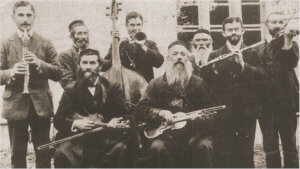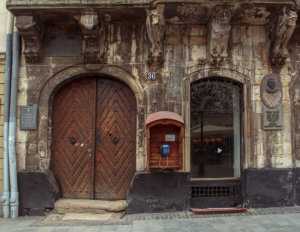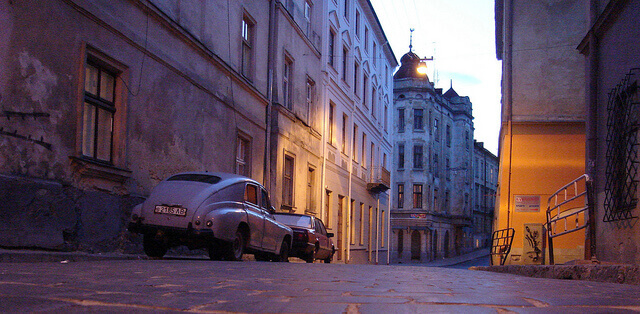Twenty-five years since the fall of the Berlin wall, the iron curtain continues to project its shadow across half of Europe. This was confirmed to me a few days ago, talking with a group of friends for who the term Galicia indicated solely a region in the North West of Spain. Santiago di Compostela, le Rías baixas, La Coruña and its football team, bagpipes: all these beautiful symbols are by now so familiar that most seem to have forgotten that on the border between Poland and Ukraine there is another Galicia, one with an infinitely richer and more tragic history than that green and rainy corner of Spain.
This lost Galicia, which in Western Europe has been disregarded in the last fifty years, is the subject of an extraordinary, revelatory book by the Austrian writer Martin Pollack: Galicia: a journey through the lost heart of Central Europe. It’s a hard project to define: part reportage, part guidebook, part historical narrative, but most especially it is homage to that piece of Europe which between the end of the 18th century until 1919 was part of the kingdom of Galicia and Lodomeria, along the confines of the Habsburg empire.
It is ultimately a travel book, composed of fragments of stories, memoir and poems of authors who were writing in Polish and German in particular. We encounter the symbol of Habsburg literature itself (Joseph Roth), great names who have fallen into neglect (Bruno Schulz), others who are less well known and less translated (Józef Wittlin e Karl Emil Franzos), and others still who have never been known in Western Europe (Ivan Franko).
Carried by the hand
When the horde of German barbarians came to Poland, the Yiddish population fled its cities and villages, not one child was left in its cradle, not one old man remained in his place.
Pollack, the orphaned child of a Nazi soldier, is a long-term scholar of Poland, translator of Kapuściński, and knows his literary material very well, as well as the places in the background. Nonetheless, the author remains voluntarily in the shadows. Instead he takes the reader by the hand, guiding them to discover new texts, writers and spaces with great discretion, the sign of a deep sensibility and also one of the characteristics of good narrative journalism. There is very little discussion in the first person because the author knows it is his job, first and foremost, to let his sources speak. And so the stories escape, details become protagonists, atmosphere, colours, voices, sounds take form and resonate as we read.
And in Galicia, the stories are infinite: there is the Boryslav oil boom, a long dusty street lined with the shacks of those seeking riches, “the stinking miracle of oil”; the luxury palace of the miracle-working rabbi of Sadhora, a point of pilgrimage for Jews from Odessa to Moscow; the poor Ruthenian peasants of Naguyevici, who dreamed of emigrating to Brazil; the shtetl Jews, who lived in the blackest poverty, with their miserable wooden houses, taverns, the propination of spirits; street vendors, bakers, weavers, shoemakers all with one idea in mind: to escape and reach America to get rich.
Each of the more or less small stories are contained within a larger history, that of a universe that was a crucible of peoples, languages and religions, and which was annihilated, cancelled, reduced to a skeleton by war and Nazism.
“When the horde of German barbarians came to Poland, the Yiddish population fled its cities and villages, not one child was left in its cradle, not one old man remained in his place,” so reports Itzak Katznelson in the Song for the Yiddish people condemned to death. The shtetl, for their part, simply went missing, in the cities they were confined to the walls of the ghettos, the synagogues were vandalised and destroyed. The Jewish culture of Eastern Europe disappeared forever.
A personal monument

Given that the Pollack has dedicated an entire book, The Dead Man in the Bunker, to his Nazi father, one can think of Galicia as a second stop in a journey to rebuild his identity in light of this patricide.
The book could certainly be seen as a personal monument, something Pollack wanted to dedicate to a universe that was devastated by the complicity of the man who brought him into the world. But if by writing Galicia the author was searching for atonement for some sense of paternal and collective guilt, that which ended up on the page is not so much a search for absolution as much as a sincere love for the dusty charm of these borderlands.
Just like Alfred Döblin before him, in his Journey in Poland, Pollack follows railway lines that were once great symbols of modernity and imperial power and which still sprawl through this land today.
Like the region’s theatres, which were often built on Viennese models, in the provincial cities of the Austro-Hungarian empire the stations were likewise essential spaces: they would be visited almost like monuments, often boasting, for example, the best restaurants. These were the umbilical cords that maintained an open relationship with the capital. The train lines that Pollack travels along in his journey, however, do not stop at the frontiers of the historic Galicia, but cross into even more remote parts of the old empire, lands now divided between Ukraine and Romania.
Many pages are dedicated to Čërnohora, the black mountain, and to the hutsuls, a population of mountain nomads “who some recognise as the remnants of Goths and Scythians. Others maintain that they are the descendants of Mongols, while others still have attributed their origins to Romania.” Hostile towards any kind of authority, knights, noble brigands with axes always in their fists, the hutsuls embody the myth of unconditional liberty. When the emperor attempted to enlist them as soldiers they preferred to hide in the forest.
Their culture was celebrated masterfully by the Armenian director Sergej Paradžanov in the 1964 film The Shadow of Forgotten Ancestors which tells the love story of two young people, Ivan and Marička. It blends the blinding white of the snowy Carpathian mountains with the blood red of murders and vendettas, and with great poetic force represents the symbiotic relationship this population has with nature. In the village of Verkhovyna you can still visit the wooden hut where Paradžanov lived as he worked on the film, where only local people were residing, while in the town of Kolomyia the museum of hutsul culture is testament to extraordinary wooden objects carved with an almost surprising expertise for such an isolated mountain people.
The pleasures of tourism
In 1919 there were more than 47 thousand Jews, half of the population, and they had 78 sinagogues at their disposal.
Travelling a little further south we arrive at the beech wood forests of Bukovina. The centre of the region, and south-western outpost of the empire until 1919, on the frontier with Bessarabia in Ottoman times, is one of Europe’s great literary cities and once had as many names as it did linguistic and cultural spirits: for Germans it was Czernowitz, Jews, Tschernowitz, the Jerusalem of the carpathians, for Romanians Cernăuți, then the Soviet Černovci, and finally the Ukranian Černivcy.
This was the city of Paul Celan, the Jewish poet writing in German, and of Gregor von Rezzori, who wrote about it famously in Memoirs of an Anti-Semite and made it the centrepiece of his most celebrated novel An Ermine in Czernopol. It was also the home of figures like Aharon Appelfeld and Karl Emil Franzos.
Before the war it was inhabited by Germans, Romanians, Poles, Ukranians, Armenains and Roma. But especially by Jews: in 1919 there were more than 47 thousand, half of the population, and they had 78 sinagogues at their disposal. Today an old temple remains which has been converted into a cinema. But in reality the Jewish cemetery in the suburbs of the city is the last testimony of a bygone age, with very few burials later than 1945. In the city today there are no more than 300 Jews.
As Karl Schlögel writes in Archipelago Europe, certain “landscapes only really exist in old yellowing photographs” and yet “Czernowitz is a name that is not just a part of literature, but which relates to a city which really exists and which you can visit.” Of course, until a few years ago it was difficult to find anyone who knew how to direct a tourist to the address of the birth-house of Celan, but if one embraces this now almost fully Ukranian city, only a simulacrum of the old cosmopolitan Czernowitz, then it can be fulfilling to go in search of traces of the past, from the metropolitan palace, now converted into a university, to the signs of the old Jewish workshops.
After a detour to Brody where Joseph Roth and Israel Zoller were born – the latter of whom was chief rabbi in Rome during the second world war before converting to Catholicism under the name Eugenio Zolli in 1945 – Pollack’s journey cannot but conclude in the heart of the region, in that little Vienna which represents the very essence of these lands on the Habsburg borders. His final stop is Leopoli, modern day Lviv, which from 1772 to 1919 was the cultural and administrative capital of the kingdom of Galicia and Lodomeria, before coming part of the Polish republic, being annexed by the Soviets, occupied by the Germans and then returned to the Soviets. It has been part of Ukraine since 1991.

Here it is as if Pollack finally decides to abandon himself to the pleasure of being a tourist. The book becomes almost a Baedeker for travellers curious to go in search of what remains of a city of the past which was transformed by the war, which killed the religious and linguistic richness, and then fifty years of communism which submerged it in homogeneous grey like most of Eastern Europe, with the same warehouses with the writing produkty and the smell of cheap gas oil in the air.
At first this vision is hard to overcome, but one has to admit that Lviv has managed to preserve certain specific local identities that render it different to other centres of ex communist Europe that have lived through more profound and decisive transformations: Budapest and Prague for example.
It is still possible for example – for very few grivne – to rent a room without a bathroom in the historic hotel George, to peek from the outside at the old Moorish decorations of the old Israeli hospital, which is today a public hospital, to push on to the monumental cemetery of Lyčakiv, to admire the secessionist frescos in the Armenian cathedral, to go in search of art nouveau decorations in the porches of old houses, and the last surviving Yiddish signs in the alleyways around the market.
An indefinable city
The holocaust destroyed the Jewish component, and then in 1939, with the Molotov-Ribbentrop pact, Leopoli began to lose its Polish population.
Yet Leopoli – or better Lemberg, its imperial name – has never been just a Jewish, Polish or Ukranian city. It was all of these things together. Then it was transformed, living through that phenomenon which Schlögel calls urbicide, and in the middle of the 20th century a collection of vital cultural and social centres became nothing more than a conglomeration of streets and buildings. This kind of mutation can be seen in its most dramatic form in the Russian city of Kaliningrad, the old Prussian Königsberg, which was devastated by architectural violence.
Leopoli, on the other hand, managed to conserve its artistic richness, but due to the war had to renounce the ethnic and linguistic aspects: the holocaust destroyed the Jewish component, and then in 1939, with the Molotov-Ribbentrop pact, the city began to lose its Polish population (which, in a sort of irony, went to substitute the captured Germans of Wrocłow which in the meantime had passed under the sovereignty of Warsaw.)
Other than Pollack’s Galicia, the memory of Leopoli, is at the centre of the Polish poet Józef Wittlin’s Moj Lwów, a text released for the first time in New York in 1946 and recently republished in English by the London based publisher Pushkin Press in the book City of Lions.
In love with his adopted city – a “prodigal son” – Wittlin is conscious of the changes that he has lived through and observed from the other side of the ocean, and writes with disenchantment and melancholy: “Where have you finished, benches of Leopoli, blackened by time and rain, rough and chipped like the bark of medieval olive trees? Who, and in what language, calls you beloved today?”
The chapter from Galicia dedicated to the city, Moj Lwów can also be read as a tourist guide: there are churches, palaces, parks, mythical figures, like the good natured petit bourgeois kołtun, or the street urchin known with the magic term batiar. And there is a brilliant description of the people themselves: “their essence is a unique mix of nobile and rascal, wisdom and stupidity, of poetry and vulgarity.”
In the end the city remains indefinable, absent of a definite form, and as such infinitely fascinating. This is the same peculiarity that the Polish poet Czesław Miłosz attributes to the character of Eastern Europeans, where “specific differences can result in an exterior and interior formlessness. Qualities such as avid intellectualism, passion for debate, a sense of irony, a connection with feeling, spatial and geographic imagination derive from a fundamental defect: to never become adult, to be governed, consequentially, by the sudden flux and flow of internal chaos. One can only find a form in a consolidated society.”
Whoever has had the good fortune to meet Polish travellers in some forgotten place – and perhaps has heard many such stories during a car journey, organised alone just after the fall of the Soviet Union in search of Siberia on the tracks of the Decemberists – knows well that what this mix of curiosity, unconsciousness, imagination and openness means.
Glowing settings
How is it possible to venerate the myth of ‘Greater Hungary’ and at the same time ride the legend of an ethnically pure community, if not by appeal to brazenly racist and colonial logic?
But returning to Pollack. The plural nature of the places and cities described in Galicia and in the other texts cited helps us to confront the untruth which is now at the core of the political narrative of the nationalist government of two countries in this part of Europe – Poland and Hungary – whose power is founded on the myth of ethnic and cultural homogeneity. Their mystification could not be more glaring. The emphasis on ethnicity in the new Hungarian constitution, approved in 2011, the total refusal to accept refugees, the insistence on Christian values as an integral part of national identity: such positions are in flagrant contradiction with the history of the Hungarian and Polish peoples.
Before the war 40% of the population of Warsaw was Jewish, and only slightly lowers figures could be found in Łódź, Kraków, Lublin and many other cities. Vilnius was a great centre of European Jewishness, and Roma, Ukranains, Armenians, Germans and even a small minority of Muslim tartars lived there. Even in Budapest before the war, Jews made up a quarter of the total population. In the centres of ‘Greater Hungary’ the varieties of languages and religions is even more remarkable: the Kassa (today Košice in Slovakia) told by Sandor Marai, himself of German origins, in Confessions of a Bourgeois is still home to the ruins of the magic hero Ferenc Rákóczi, but until 1945 it was also home to a large Jewish community, as well as Slovakians, Roma, Ukranains and Germans.
The same is true for the cities of Transylvania in today’s Romania like Nagyvárad (Oradea in Romanian), Temesvár (Timișoara) or Kolozsvár (Cluj Napoca): here too there were Romanians, Roma, Germans, Jews and Serbians. How is it possible to venerate the myth of ‘Greater Hungary’ and at the same time ride the legend of an ethnically pure community, if not by appeal to brazenly racist and colonial logic?
Other than helping us discover writers and places unjustly forgotten, then, Martin Pollack’s Galicia speaks in some way about Central and Eastern Europe of today. In addition it has the great merit of helping us to unmask the manipulations of nationalism, wherever they are manifest.
This article was first published in Italian in Internazionale and was translated, with permission, by Jamie Mackay.
![Political Critique [DISCONTINUED]](http://politicalcritique.org/wp-content/uploads/2015/09/Political-Critique-LOGO.png)
![Political Critique [DISCONTINUED]](http://politicalcritique.org/wp-content/uploads/2015/09/Political-Critique-LOGO-2.png)
